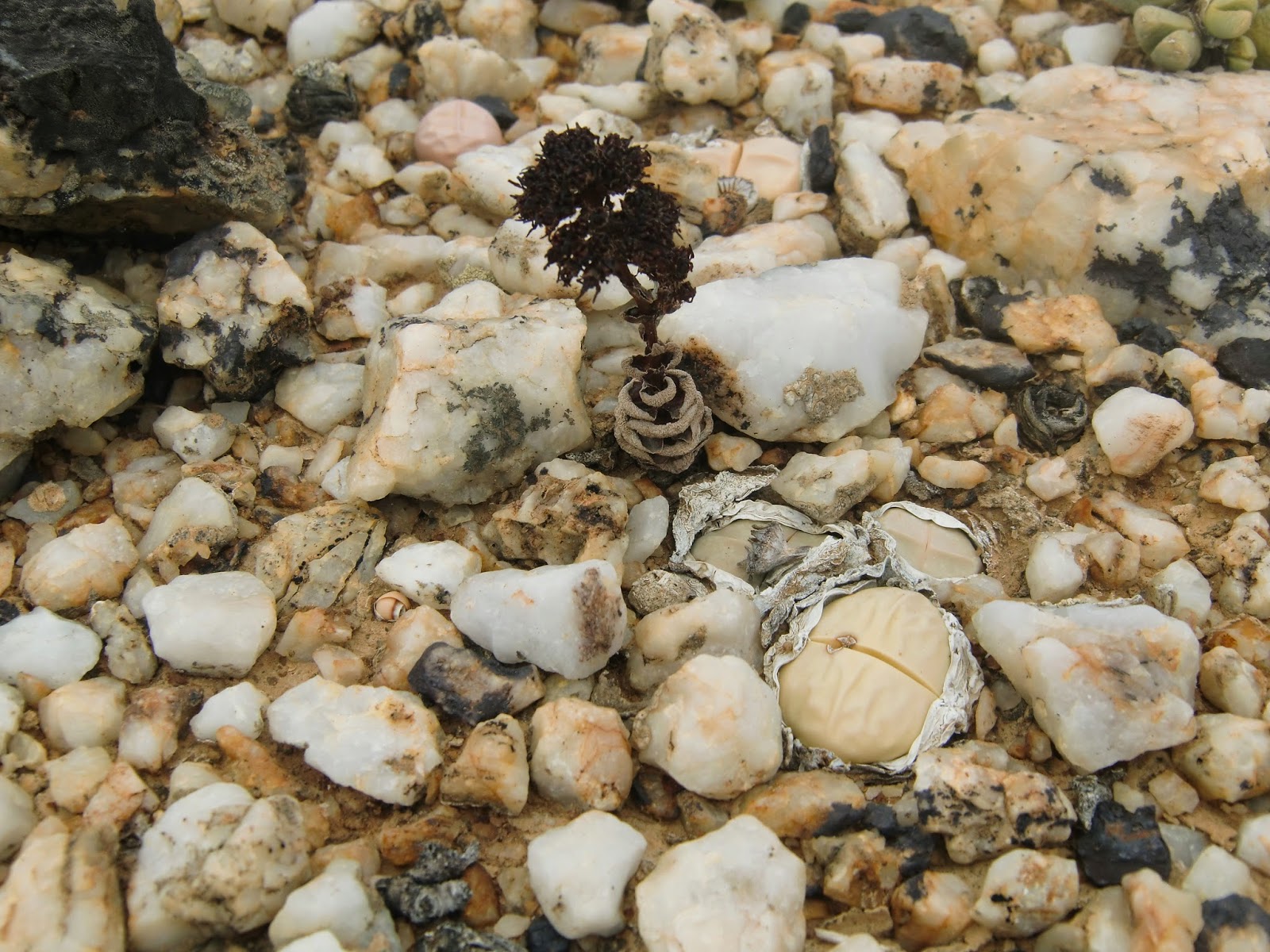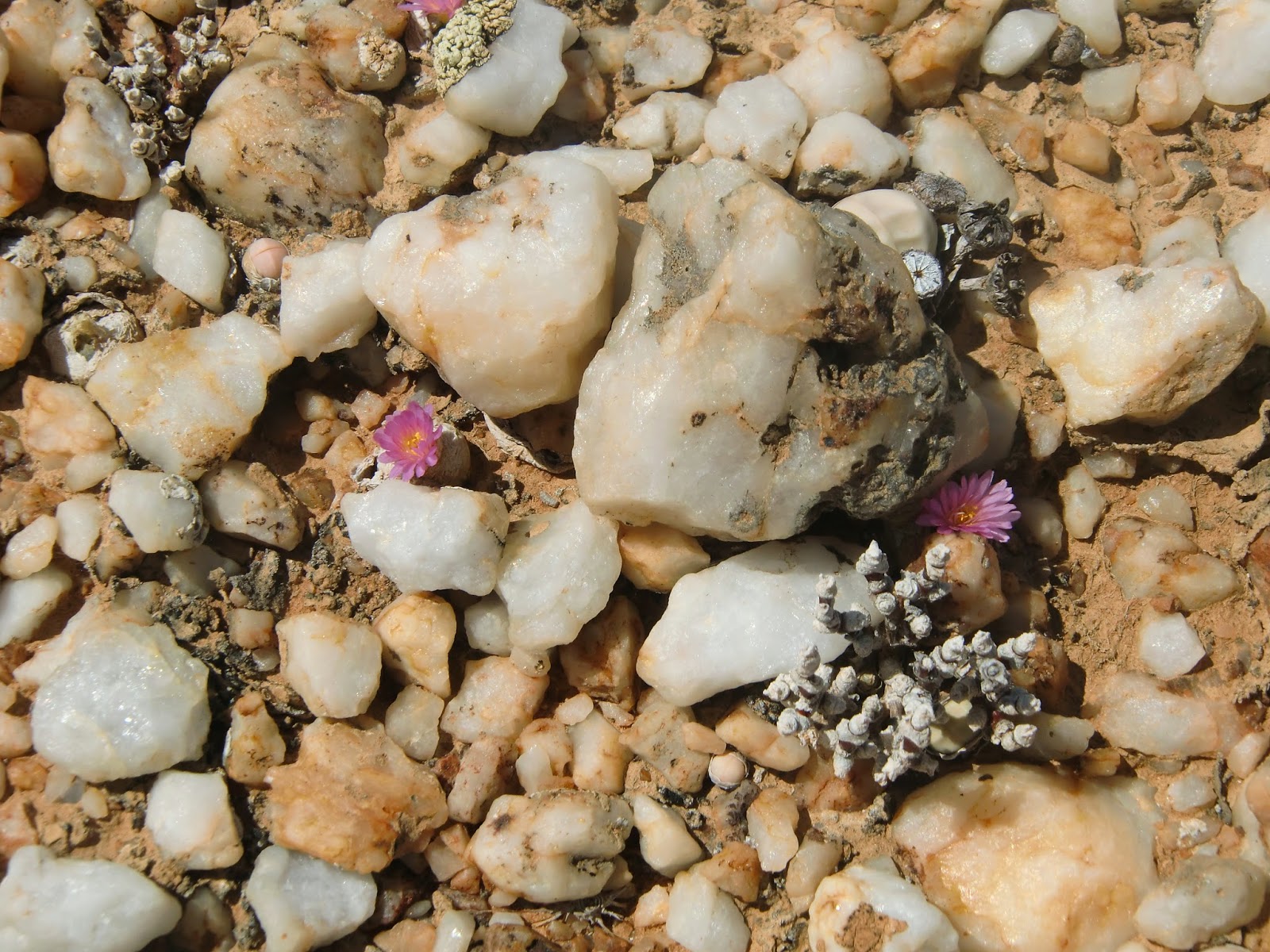The landscape is stark and beautiful. Imagine a desert similar to the Southwest United States, but every small plant you see is actually some sort of succulent. Scattered throughout are seams of quartz gravel (laid down millions of years ago when the area was a shallow sea). At first glance, these seem to be barren strips in an already harsh environment. However, a closer look reveals a vast variety of life in these micro-habitats. In fact, many of the rocks are actually plants.
The Afrikaans settlers of the area certainly had a morose attitude about the region. Knersvlakte translates to fields or flats of gnashing teeth. This could be from frustration or an onomatopoeic description of the sounds wagon wheels made rolling over the gravel substrate. There is an area nearby named Gifberg, which means Poison Mountain. Two of the sites we studied were Groot Grafwater (Great Grave Water) and Moedverloren (strength forsaken).
Despite that, I found the area to be lovely.
Our days were long, though honestly not as hard as I expected. We were up, breakfasted, and in the field before the sun was up. We then spent the day at the four varying study sites as well as driving between them down lengthy dirt roads, passing through numerous gates in the patchwork of private farms and nature reserves.
 |
| Afrikaans for "Please shut the gate, thanks" |
The hardest part was seed collecting. Each of the plants under investigation produces seed pods that can contain anywhere from 5-300 seeds at first. However, this is late summer (almost as far from the last rainy season as possible). Seeds may have already been ejected or weevils may have bore into the pods to consume the seeds. Therefore, we had to develop strategies (on our hands and knees on gravel) for identifying fresher, intact seed pods that could supply Seth with the number of seeds he needs. As this required light, this task was also attended to in the hottest parts of the days. Delightful.
We also had to regularly water ourselves and reapply sunscreen.
Seth and I stayed in an abandoned farm house on land donated to Cape Nature by the World Wildlife Fund, who are buying up sheep farms in the area to preserve this ecosystem. It was highly rustic, with not electricity or water. We returned after sunset from our day's work to light some candles and cook dinner over a camp stove. We would sometimes then spend time with dissecting microscopes (lit with head-torches and flashlights) examining our seed collections, chatting about the next day's priorities, or just exchanging movies and webseries worth checking out (check out Suzelle DIY on youtube for some entertaining, useful, and chuckle-worthy home-hacks). At one point, I even spent time with my biology notes by candle-light, trying to put in some prep time for this week's test.
 |
| One of our little home-invaders |
 |
| Conophytum Calculus - one of the cuter species that Seth is researching. The leaves are tiny ball-shaped structures that look like a baby muppet's head. This one was beginning to bloom. |
I was always exhausted, but would force myself to stay up a little so I could catch the stars. Being so remote, the sky is just littered with stars. The Milky Way and the Magellanic Clouds (two tiny cluster galaxies that orbit our own) were highly visible. Sadly, I have no pictures of that.
During our time in the field and along the dirt roads, we saw a plethora of animals. In addition to large numbers of birds (Seth is a birder, and was rattling off names left and right as various creatures took flight as we passed, almost none of which I have retained), we saw steenbok, springbok, jackals, meerkats. There were two owls who nested near one of our gates who were unfortunately regularly had to disturb. Pale chanting goshawks were everywhere, as were jackal buzzards and kestrels.
Still, the plants are the superstars of this area. At times, the area looks like a dry land coral reef. Other times, the micro-succulents do a great job hiding among the rocks, and only a close examination of the land will reveal their presence.
Count the plants!
 |
| Even the slate breaks in such a way that looks like disintegrating wood. |
 |
| And yes, this guy came along too. |




























No comments:
Post a Comment